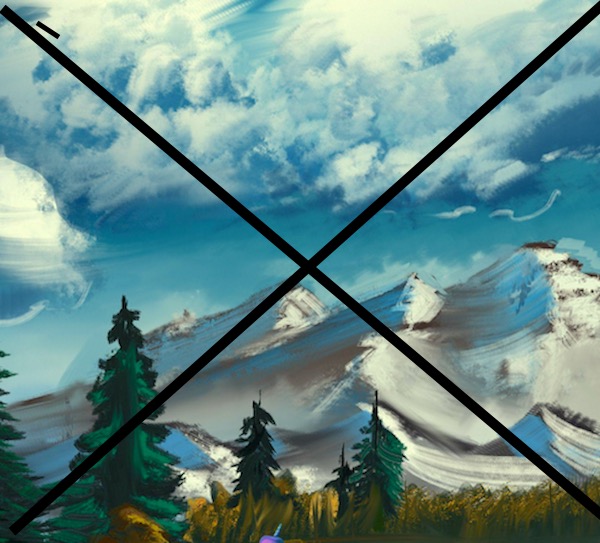
by Christina Waters | Oct 31, 2024 | Art, Home |
What I have to say will come as no surprise.
But it will probably offend many of you.*
These remarks are long overdue—they spring from having seen too many sow’s ears made out of sow’s ears. And too much motherly “support” for the arts that is fatal to authentic art-making. Supporting is condescending. In some cases it amounts to virtue signaling. E.g. I went to the Symphony so that I could say I went to the Symphony.
Being a critic, especially in a small community, is a thankless task. Everyone with a performance, or a concert, or an exhibit seeks critical approval. But few want to hear critical appraisal.
Pro tip: if you consistently tell the truth, if you’re fair in your evaluations, people will trust what you have to say. But if you always praise every performance, every dance recital, every plein air show, etc. etc. no one will trust you.
“But I read a rave review in the __________. ” Yes, but did you believe it? Rave reviews only have credibility if the critic doesn’t give everything a rave review.
I am invited to many openings
And rehearsals, performances, and events. It’s wonderful to be asked. I try to go to ones that my intuition tells me might offer surprise. Pieces that show skill, but even more; that trigger some new insight. Pieces made by artists who can shape a narrative, or produce an unexpected image that points and reveals beyond itself.
There’s always a place for enthusiastic amateurs, people who enjoy making decorative visual work or playing music and who are generous about sharing. Creative people abound where I live in Santa Cruz, and many are self-aware enough to know when the work deserves a professional showing or when it’s wiser to invite family and friends to come admire at a private venue. It takes major chutzpah to charge audiences $30 to see/hear your work. And so the work must be able to justify the ticket price and to bear scrutiny.
Mothers Love Everything
Consider this: My mother loves everything I do, even though as a painter herself she doesn’t mind chiming in with a few choice words about composition or color choices. But my mother is subjective. Mother’s love what their children do. Refrigerator doors display the evidence. A critic is not the artist’s mother.
Be a true friend
If supporting your friend’s artwork means never daring to say a critical word about their efforts, then you’re not only cheating your friend of expanding his/her horizons—you’re lowering the bar of quality for everyone, the insanely gifted as well as the up-and-comers. You’re proclaiming that whatever they do is good enough for you. You’re patronizing your friend. It’s true, you might bruise someone’s feelings by offering a critical comment. But to never risk hurting someone’s feelings is to stay safe and agreeable (and phony!). It’s throwing away the chance to have an authentic discussion, to engage in some nitty gritty about artistic intentions.
Hell yes it’s easier, and safer, to simply smile and tell your friend/acquaintance that their work is “interesting.” That you’re glad you came to see it.
We’ve all done that. In the long run, it’s a sign that you don’t expect much from that person.
True story
My mother’s friend Donna was a woman who made little animal figures out of (so help me) cookie dough mixed with some hardening agent. Donna gave all her close friends one of these little figures for Christmas gifts. My mother, a sweet woman without a single enemy in the world, always complimented Donna on her annual dough figurine. And sure enough, next year Donna gave my mother the exact same species of dough figure. This went on year after year.
My mother had encouraged her friend and she got what she deserved. A cabinet full of kitsch. [After Donna’s death, I opened my mother’s china cabinet, grabbed a half dozen of these misshapen monsters, and hurled them into the garbage.] And Donna, a woman who might have pushed herself to more adventurous results, stayed right where she was on the felt-and-sequin ladder of tackiness (where my late Auntie Da is the reigning matriarch.)
Don’t get me wrong, I’m not knocking the creative urge. It’s a universal impulse, and it’s a lot healthier than vaping or using a leaf blower. It’s done for the sheer love of it. But you don’t ask a critic to come see your new macramé piece expecting a published review.
If you do expect some critical response to work you’ve presented in public, be prepared for honest feedback. Something along the lines of, “Have you considered casting a trained dancer in the role of the acrobat (rather than your arthritic father-in-law)?” or, “This seems like a terrific start to something. If you explore this style further, who knows where it will lead.”
Another pro-tip
As a longtime restaurant reviewer I learned to accentuate the positive. If the food was mediocre, I wrote about the decor. If the food was bad, I didn’t write about it at all. This is a small town.
I will never tell you I loved your work, if I didn’t. If I felt it was unclear, or naive, or cloying, or just plain silly, or that it had been done before many times (and better), I will strive to be polite and say nothing. Lying to someone doesn’t help them grow or introspect about what it is they’re trying to express. It simply perpetuates the ordinary, the easy, or the embarrassing. Or worse. It deludes a serious practitioner into self-satisfaction, rather than encouraging them to go further. We already have plenty of that. We each should be aiming for the stars. But you’ll never aim there if you are consistently told that you already *are* there.
Final pro-tip
Just because someone is a nice person and has put a lot of effort into a piece of work doesn’t make it good. Hard work doesn’t equal insight. Quantity does not equal quality. A critic who refuses to coo platitudes is actually encouraging artists to push further. Those who come out to support are like mothers showing up for their child’s recitals. They are doing their duty.
To unreflectively applaud everything is to fail the entire mission of artistic growth. Those who come out to support don’t engage with the work, or the artist. They neglect to educate themselves in the history or vocabulary that would help to stretch and strengthen their own insight into what the artist is doing. They stick to safe, feel-good categories. “I love your colors,” or worse. They simply walk through an exhibit, or sit for a concert, without bothering to assess or discuss what they’ve just seen and heard.
Don’t be that kind of art consumer. Ask more of yourself. And of the artist.
Stop supporting the arts. It’s condescending! Authentic art doesn’t need to be supported. Go because you expect to be excited, swept away, surprised, delighted, and impressed. To have a good time, not to be worn out by obligation.
_______________
* This piece was prompted by my recent experience of an art “event” so utterly misguided, embarrassing, and narcissistic as to be almost beyond comprehension. Rather than ruin someone’s day, or indeed their art practice revival, I sat there and endured an hour I will never have back. The other observers were there to “support” the artist’s effort, which was not a pro bono affair. A hefty chunk of change was charged. I was appalled and insulted. Hence this post.
Food for thought: Does Patti Smith need your support? Or a concert by professional musicians? Or a play by Shakespeare? Would you go hear Jonathan Franzen read because you want to support him?
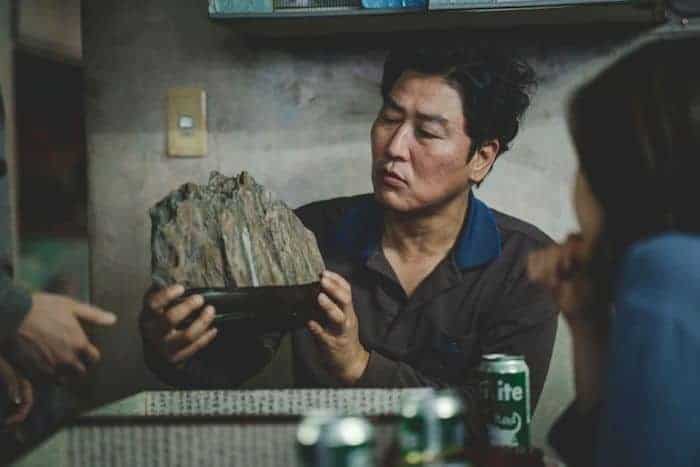
Parasite: a 21st Century Fable
by Christina Waters | Nov 15, 2019 | Art, Home |
Parasite, the new film by Korean auteur director Bong Joon Ho, is not only gorgeous to look at, it presents a harrowing satire on the state of class inequity in the 21st century. It’s hard to think of a recent film that packs this much metaphorical power. Set in Korea in the midst of a Dickensian disparity of wealth—the Kims live in basement squalor, the Parks live in upscale serenity. But it could be anywhere in the first world. It is here, right now, and that very fact provides the razor edge of recognition audiences feel in response to this darkly comic/existential romp that snatched the Cannes Festival’s Palme d’Or away from Quentin Tarantino (See my review of Tarantino’s “Once upon a time in Hollywood”.)
Parasite is a tale told through two families: the luckless, unemployed Kim Family headed by the extraordinary Kang-Ho Song as the father, Kim Chung-Sook as his wife, Choi Woo-Shik as teenaged son “Kevin” and Park So-Dam as his crafty hacker sister “Jessica. Determined to claw their way out of their ghetto squalor, the Kims scheme their way (I won’t spoil it) into the lives of the wealthy Park Family, led by Cho Yeo-jeong as the naive, lovely Mrs. Park and Lee Sun Gyun as style-conscious CEO Mr. Park.
 Before you know it the Kims, who’ll literally do anything to make money, manage to insinuate themselves into the heart of the Park’s splendid household. It is a symbiotic ecosystem made in the hellishly brilliant imagination of this director.
Before you know it the Kims, who’ll literally do anything to make money, manage to insinuate themselves into the heart of the Park’s splendid household. It is a symbiotic ecosystem made in the hellishly brilliant imagination of this director.
[Above we find the resourceful Kim siblings finding the best signal from their neighbor’s wifi right above the toilet.]
Mr. Kim becomes Mr. Park’s driver, Mrs. Kim is the new Park housekeeper after cleverly managing to get the former one fired (the scenes here are laugh out loud funny). The son becomes tutor (and lover) to the Park’s daughter, and his sister poses as an art therapist for the Park’s young son, who is obsessed with American Indians.
 The house itself is a key player in what will reveal itself to be Bong’s sly-handed tale of social inequity. An architectural masterpiece (designed by director Bong and made especially for the film) the sleek modernist house is laid out in interlocking levels. The living room’s enormous wall of glass overlooks an oasis of green lawn bordered by a manicured hedge.
The house itself is a key player in what will reveal itself to be Bong’s sly-handed tale of social inequity. An architectural masterpiece (designed by director Bong and made especially for the film) the sleek modernist house is laid out in interlocking levels. The living room’s enormous wall of glass overlooks an oasis of green lawn bordered by a manicured hedge.  This hermetic world insulates the Parks from any unsightly social reality and makes a painful contrast to the mess and chaos of the Kim’s basement apartment. Most importantly to the director’s storytelling, the house also contains a secret passage into yet another domain—and a ghastly secret buried deep within the heart of lavish wealth.
This hermetic world insulates the Parks from any unsightly social reality and makes a painful contrast to the mess and chaos of the Kim’s basement apartment. Most importantly to the director’s storytelling, the house also contains a secret passage into yet another domain—and a ghastly secret buried deep within the heart of lavish wealth.
Bong’s social commentary is never heavy handed, but it spares no one.
How this secret is discovered, what it contains, and where its layered metaphors lead are the elements driving a tsunami of loss, compassion, violence, joy, and ultimately a fairytale ending.
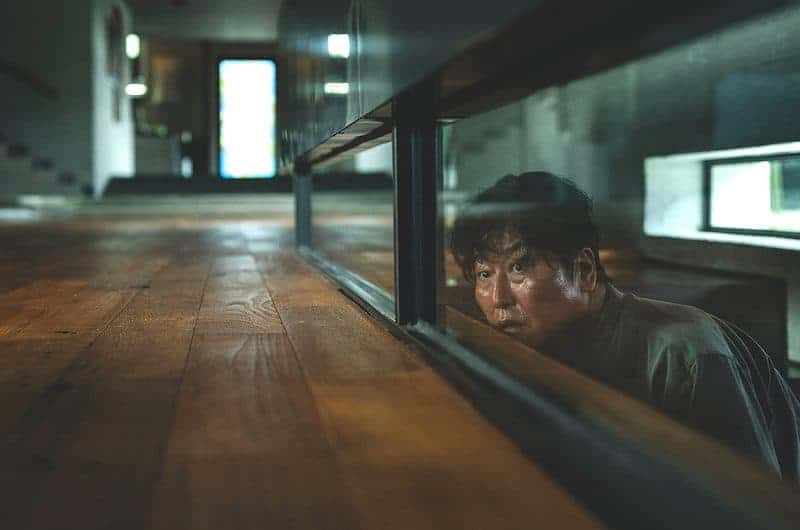
Parasite is powered by poetic cinematography, scored with Western classical music (another edgy dig at Korean social pretentions) and acted by a cast of brilliant players as capable of slapstick as heartbreak. I laughed my way through this film, even during its most terrifying scenes. The two families and the social codes they embody are turned inside out more than once, and never in predictable ways. All the actors are memorable, but especially lead player Kang-Ho Song, Mr. Kim [above], a frequent Bong collaborator. His broad face is roadmap of dashed dreams. As expressive as any Willem Dafoe, a savage/tender mirror reflecting Mr. Kim’s transformation—and his realization that his family’s larceny has triggered untold psychic damage. Nothing in Mr. Kim’s life has ever worked out, and Song’s face ultimately reveals despair on a Kierkegaardian scale. A great actor in a part worthy of his astonishing gifts.
Near the end of Parasite we find that just desserts are the main course of an outdoor birthday party for the spoiled Park son.  And once the shocking visual pyrotechnics have cooled down, the film draws to a haunting, eloquent close a la Charles Dickens. Desperate and ephemeral dreams, of the sort that reveal how much the rich and the poor are mutually bound in a slow dance of need, greed, hypocrisy, and desire.
And once the shocking visual pyrotechnics have cooled down, the film draws to a haunting, eloquent close a la Charles Dickens. Desperate and ephemeral dreams, of the sort that reveal how much the rich and the poor are mutually bound in a slow dance of need, greed, hypocrisy, and desire.
Parasite is a stunning cinematic fable, brilliant in every way, and for my money….unforgettable.
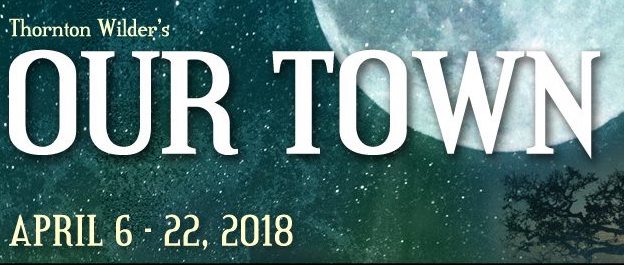
A Timeless “Our Town”
by Christina Waters | Apr 9, 2018 | Art, Home |
American playwright Thornton Wilder won a Pulitzer Prize for his finely-tuned masterpiece, Our Town. First produced in 1938—on a stage completely bare save for some chairs, two tables, and two ladders—it reveals the gritty, glorious, fuzzy reality of what Edmund Husserl called “lived time.” Not the expansive, beginning-middle-end time of fiction or daydreams. But the mundane, emotionally-troubled, worn time of everyday. The lived time that goes by so barely noticed that we, at least those of us over the age of 40, often find ourselves wondering out loud, “where does the time go?”
Thanks to skilled theater professional Suzanne Sturn, the culturati of Santa Cruz have a chance to remember just how true, unflinching, and humbling Our Town remains. Though most of the people in the opening week’s audiences had very likely seen or read the play in their high school years—like good wine, or almost anything by Shakespeare, this play just gets better, and more disturbingly beautiful with time.
Sturn herself plays the loquacious Stage Manager, the person who introduces the audience to the play, the town—Grovers Corners, New Hampshire—and the era, very early 20th century. With pitch perfect and insider wisdom, Sturn’s Stage Manager introduces us to the key residents of the town, the two families who will be joined together upon the marriage of one son George (Maxwell Bjork), and one daughter (Isabel Cruz). With unerring economy—gestures and vocal work do most of the heavy lifting in this production—Sturn moves the residents of Grovers Corners from early morning, to work and school, home again, and then long into the night.
We meet the milkman Howie Newsome (Chris Rich), the town doctor Dr. Gibbs (Dennis Hungridge), Mrs Gibbs (Susan Forrest) who is Emily’s mother, the town newspaper editor Mr. Webb (Bob Colter), and Mrs. Webb (a terrific Gail Borkowski) who is George’s mom. Everything moves smoothly, almost dreamily from the time when the young people are first discovering each other. The middle section of the play, “Love and Marriage,” deepens the awakening of human needs and desires, and introduces a few more delicious players, the town’s hard-drinking choir mistress (played by Mindy Pedlar), and jolly, philosophical Mrs. Soames (Hannah Eckstein).
In their New World Romeo and Juliet roles, courting each other from the tops of ladders, George and Emily unpeel the pain and awkwardness of youth just managing to reach something like agreement about a future together. It is so familiar, so unexpectedly new, so sparingly written, with absolutely not one word too many. Wilder is a humbling precedent for any emerging playwright.
And the final scene, at the town’s cemetery, delivers everything we know is coming. And yet we’re never quite ready for the last scene of Our Town. Sturn’s production utilizes space and time wisely. The players move up and down the aisles of the tiny theater, bringing their hopes, and ours, with them across the thresholds of mortality and whatever might lie beyond.
“Do any human beings ever realize life while they live it?” Emily asks, speaking for everyone who’s ever lived.
If there is anyone who might, against all odds, not know how the play unfolds, I won’t dwell on the final 30 minutes. It’s a surprise worth getting dressed for. But as I watched the play again, struggling for composure, I found myself watching it through my recent reading of George Saunders’ (another Pulitzer Prize winner) Lincoln in the Bardo. Somehow Wilder and Saunders each understood the Buddhist concept of mindfulness, and the need for those of us alive to be released by those we have loved, and lost. The thin, but ultimate membrane that separates life, death, and eternity.
The play itself is better than I could ever have hoped, or remembered. And this production does it justice, making all the right calls in terms of staging and timing. Kudos to the entire cast and director. Thornton Wilder’s Our Town plays at the Center Stage Theater, 1001 Center St., Santa Cruz through April 22. Rife with the magic of an imagined domain that only live theater can realize, this is a production worth two hours and 15 minutes of your time. And then some. Tickets here.

Bill Viola in Florence
by Christina Waters | Jun 13, 2017 | Art, Home, Travel |
Here was a long-awaited experience—the chance to finally see the great Pontormo Visitation along with Bill Viola‘s haunting video response made five hundred years later. There in a single darkened room was the newly-restored Mannerist painting portraying the moment when Mary reveals to her cousin Elizabeth that she is pregnant. All the mystery and innuedo, the pungent psychological drama of what might have transpired is captured in their complex gaze, the swirling folds of the gowns, the torque of the bodies as they touch and yet turn away. Pontormo’s use of a single model for two of the figures adds a sparkle of surrealism to the moment. Mary’s mother Anne watches on, and an angel—also a witness—looks directly at us, viewers across the centuries.
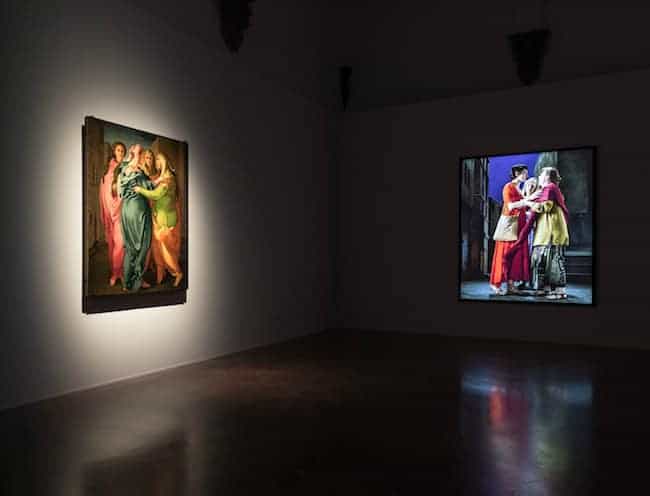 On the adjacent wall, Viola’s larger-than-lifesize figures strain against time and space in hyper slow motion, re-imagining the meeting (the piece is called The Greeting) among Mary, Elizabeth, and a third woman. Gracefully surging skirts, arms reaching out, hands about to clasp, faces registering surprise, delight, and puzzlement, Viola’s work—which takes time to unfold— forces us deep into and beneath the minds of his subjects.
On the adjacent wall, Viola’s larger-than-lifesize figures strain against time and space in hyper slow motion, re-imagining the meeting (the piece is called The Greeting) among Mary, Elizabeth, and a third woman. Gracefully surging skirts, arms reaching out, hands about to clasp, faces registering surprise, delight, and puzzlement, Viola’s work—which takes time to unfold— forces us deep into and beneath the minds of his subjects.
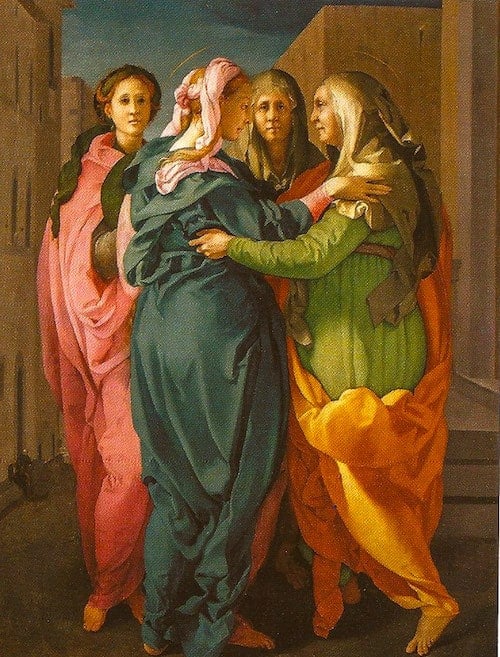 The slowed-down movements and gestures cast digital congianti onto the image painted by Bronzino’s teacher in the early 16th century. Movement inflects stillness with layers of temporal depth. Absolutely stunning. Viola’s forensic probing of an emotion-drenched moment retrieves fresh sensations we can almost taste.
The slowed-down movements and gestures cast digital congianti onto the image painted by Bronzino’s teacher in the early 16th century. Movement inflects stillness with layers of temporal depth. Absolutely stunning. Viola’s forensic probing of an emotion-drenched moment retrieves fresh sensations we can almost taste.
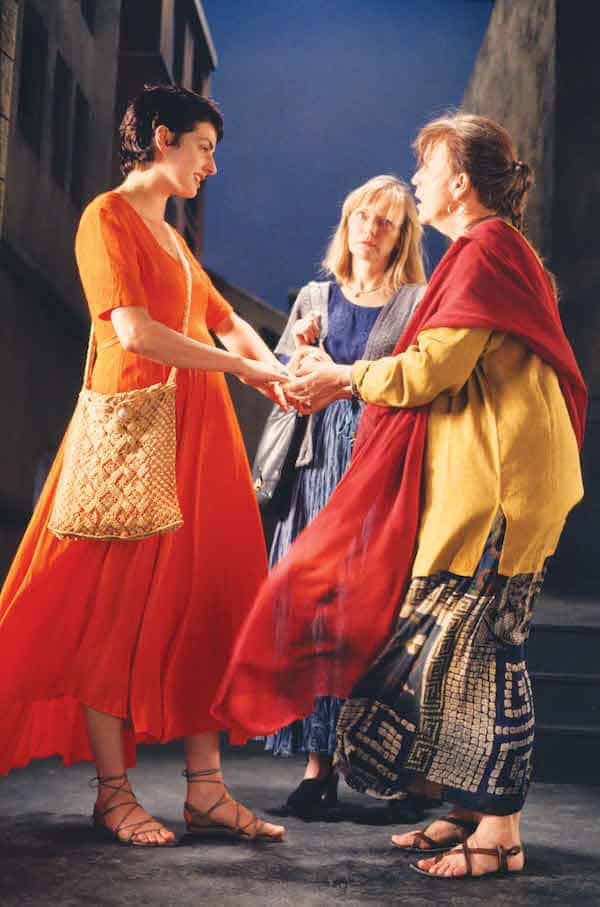 The Pontormo is triumphant, its colors brilliant as if freshly painted. A commanding palette of draped robes challenges the crimson dress worn Viola’s Mary, the magenta shawl of Elizabeth.The two works now share a secret, at once timeless and yet produced across and through time; they murmur of the same epic event. They are in league with each other. Sono insieme.
The Pontormo is triumphant, its colors brilliant as if freshly painted. A commanding palette of draped robes challenges the crimson dress worn Viola’s Mary, the magenta shawl of Elizabeth.The two works now share a secret, at once timeless and yet produced across and through time; they murmur of the same epic event. They are in league with each other. Sono insieme.
I’ve taught some of the ideas and work of video artist Bill Viola in many of my courses over the past 15 years. And the more I reflect on his comments about his work, how it came into fruition, and the various influences upon them, the more my bond with his output deepens.
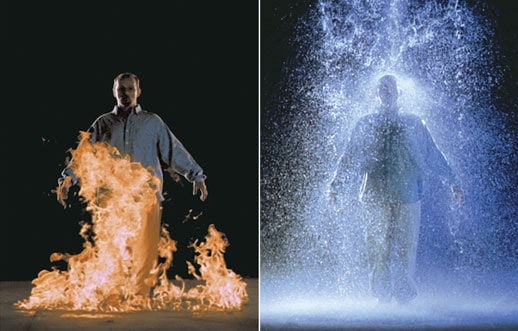 So it was with great anticipation that I took a break from operas in Vienna last month, hopped a plane across the alps, and headed for the Palazzo Strozzi in Florence. Curated with insight and largesse by Viola’s longtime collaborator and wife Kira Perov, with Arturo Galansino, the retrospective—Electronic Renaissance—honors the years Viola spent as a student and pioneer videographer in Florence. Indeed, the city opened its doors to Viola’s work, displaying pieces in multiiple sites from the Museo del Duomo to the entire Palazzo Strozzi.
So it was with great anticipation that I took a break from operas in Vienna last month, hopped a plane across the alps, and headed for the Palazzo Strozzi in Florence. Curated with insight and largesse by Viola’s longtime collaborator and wife Kira Perov, with Arturo Galansino, the retrospective—Electronic Renaissance—honors the years Viola spent as a student and pioneer videographer in Florence. Indeed, the city opened its doors to Viola’s work, displaying pieces in multiiple sites from the Museo del Duomo to the entire Palazzo Strozzi.
The real attraction for me was the chance to see Viola’s large video panels mounted in proximity with the Renaissance and Mannerist works that evoked and inspired his shimmering works. And as I had hoped, in each of the palazzo’s vaulted chambers, Renaissance works and Viola’s response faced each other, called to each other, and reinforced each other’s creative origins.
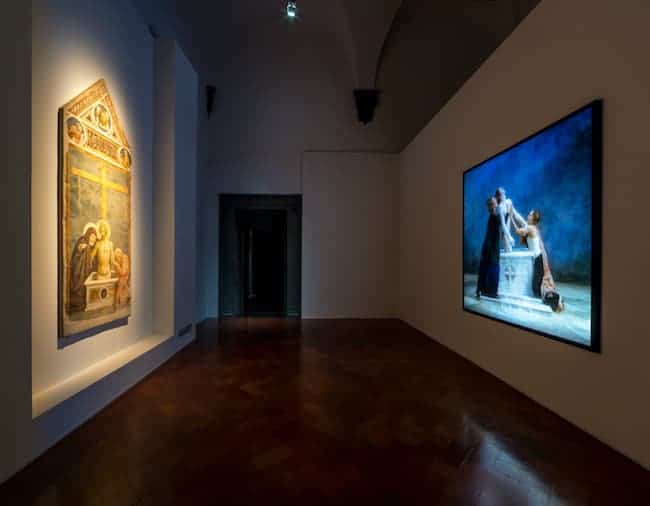 Like many of you, I had seen several of Viola’s pieces years ago at The Getty, and was familiar with his technique of hyper attenuated movement. The smallest blink of an eye, or grasp of a hand—actually happening in seconds—is stretched and lengthened into many minutes. The gestures seems to develop and bloom as we watch. Time itself unfolds through Viola’s unblinking camera, and an unseen symbolic power is revealed.
Like many of you, I had seen several of Viola’s pieces years ago at The Getty, and was familiar with his technique of hyper attenuated movement. The smallest blink of an eye, or grasp of a hand—actually happening in seconds—is stretched and lengthened into many minutes. The gestures seems to develop and bloom as we watch. Time itself unfolds through Viola’s unblinking camera, and an unseen symbolic power is revealed.
I had wandered through the cool forest of Going Forth by Day when I saw one of its five panels in Milan several years ago. Walking with the lifesized travelers of the 30 foot LED installation as they proceeded slowly across a darkened room in Florence was to enter onto a pilgrim’s journey. From room to room, I was transfixed by the glowing installations. The Crossing, one of Viola’s most famous pieces, hung suspended in the center of one huge room. On one side of the screen a man is very slowly consumed by flames as the sound system roars and crackles. On the other side, the same man is gradually, bombarded by a torrent of water, a savage deluge into which his body ultimately disappears. All that remains is the echoing of water, drop by drop. The Crossing is the most literal portrayal of Viola’s inquiry into archetypal moments of transition, of change, of ephemerality. To be human, is to be always not quite what we are. Fire and water are two moments of a single event horizon.
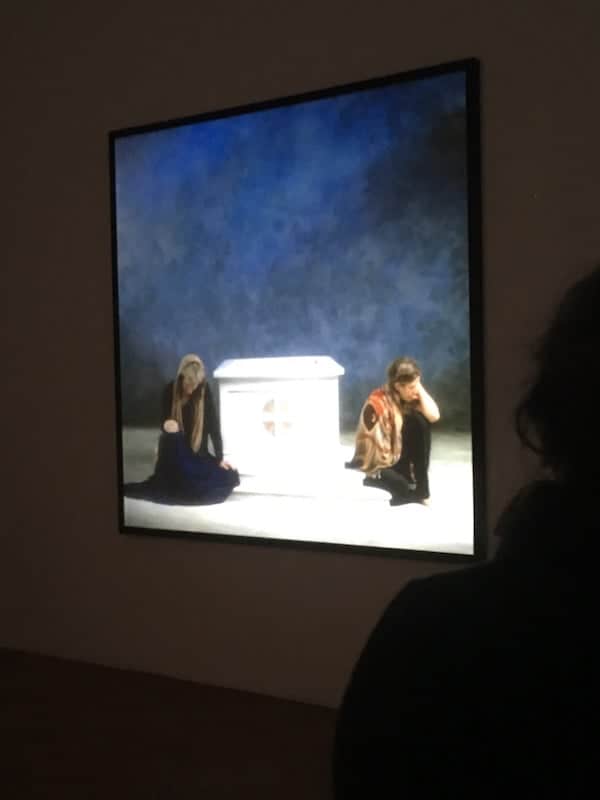 The Emergence, based upon an enigmatic and solumn 15th century work by Masolino is the exhibition’s signature work, and one in which Viola documents the naked Christ figure, emerging (as in a resurrection) and also ascending from a watery death, tenderly wrapped by two women (his mother Mary and the Magdalen, as the new testament tells it).
The Emergence, based upon an enigmatic and solumn 15th century work by Masolino is the exhibition’s signature work, and one in which Viola documents the naked Christ figure, emerging (as in a resurrection) and also ascending from a watery death, tenderly wrapped by two women (his mother Mary and the Magdalen, as the new testament tells it).
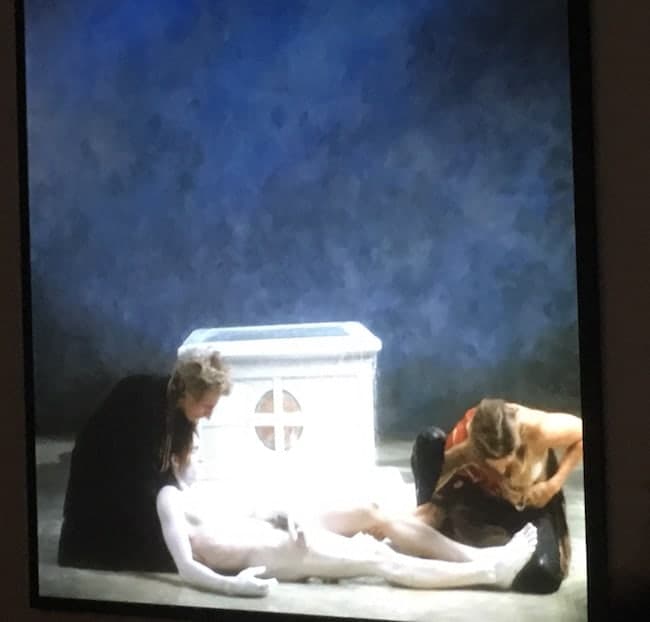 Displaying over a period of 15 minutes, the work uses its fascinating beauty (we are always wondering how it was made, noticing the arduousness of the actors’ movements) to enunciate a mysterious truth. We are watching a familiar moment, a primal moment we know in our bodies. Yet that moment has no name. It is deeper than naming. Viola knows that. The piece is nothing short of profound, kept watch over by the original Masolino alterpiece.
Displaying over a period of 15 minutes, the work uses its fascinating beauty (we are always wondering how it was made, noticing the arduousness of the actors’ movements) to enunciate a mysterious truth. We are watching a familiar moment, a primal moment we know in our bodies. Yet that moment has no name. It is deeper than naming. Viola knows that. The piece is nothing short of profound, kept watch over by the original Masolino alterpiece.
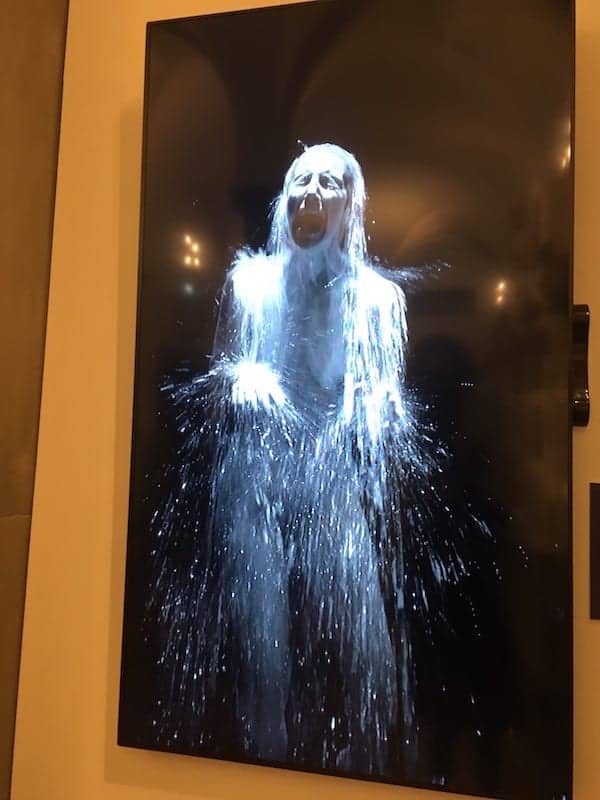 Dinner of pappardelle and wild boar ragu, chased with Chianti Classico. Next morning I saw more Viola pieces at the Museo del Opera del Duomo, and was ensnared in the tragic mirroring of Donatello‘s carved wood Magdalen—a work of numbing sorrow with Viola’s Acceptance—a lifesize video of a wailing nude woman inundated with torrents of water. The carved wooden animal hides covering the Magdalen were exactly echoed by the roiling flood, a stream of slow-motion tears. Stunned, I headed back for a second viewing of the Palazzo Strozzi show. Ten dollars was never better spent.
Dinner of pappardelle and wild boar ragu, chased with Chianti Classico. Next morning I saw more Viola pieces at the Museo del Opera del Duomo, and was ensnared in the tragic mirroring of Donatello‘s carved wood Magdalen—a work of numbing sorrow with Viola’s Acceptance—a lifesize video of a wailing nude woman inundated with torrents of water. The carved wooden animal hides covering the Magdalen were exactly echoed by the roiling flood, a stream of slow-motion tears. Stunned, I headed back for a second viewing of the Palazzo Strozzi show. Ten dollars was never better spent.
 And here I walked into my own epiphany. I moved from darkened room to darkened room on Viola’s shamanic journey. The exhibition had cast a hypnotic spell, into which I, the seeker, descended deeper and deeper until I came to the room with a piece I had known about for many years—Catherine’s Room. Five panels showing the stages of a life, the time of life (youth, middle-age, etc.) symbolized by the view of a tree outside Catherin’e window. In her youth, the tree is beginning to bloom. As she grows into maturity, the tree is seen awash with green leaves, the sun high in the sky. As she grows older, the sky outside grows darker, the tree’s leaves fall. In the final panel, we watch as she makes her bed and lies down in it pulling up the covers. The window is dark, night has fallen.
And here I walked into my own epiphany. I moved from darkened room to darkened room on Viola’s shamanic journey. The exhibition had cast a hypnotic spell, into which I, the seeker, descended deeper and deeper until I came to the room with a piece I had known about for many years—Catherine’s Room. Five panels showing the stages of a life, the time of life (youth, middle-age, etc.) symbolized by the view of a tree outside Catherin’e window. In her youth, the tree is beginning to bloom. As she grows into maturity, the tree is seen awash with green leaves, the sun high in the sky. As she grows older, the sky outside grows darker, the tree’s leaves fall. In the final panel, we watch as she makes her bed and lies down in it pulling up the covers. The window is dark, night has fallen.
 Each panel is also a video piece, so we can watch each image unfold in slow-motion time. And we can take it all in at once, embrace the entire polyptych as a whole.
Each panel is also a video piece, so we can watch each image unfold in slow-motion time. And we can take it all in at once, embrace the entire polyptych as a whole.
In the next to last panel, Catherine begins to light a large array of votive candles. One by one, each candle is patiently lit until the whole image is ablaze with flickering light. Going back and forth among the panels I suddenly realized that Viola was using his Buddhist savvy (agenda?) to reveal the life of a saint (a medieval panel of St. Catherine of Siena’s life faces the Viola installation). But he also showed me much more. All the moments, milestones, events of a human life occur simultaneously. Not sequentially. Everything is now. Change, movement, youth, age, birth, death—are all illusions, mere words. Catherine’s Room is every room. Her activities occur outside linear time.
I also realized the obviousness of my response. And its profundity.
There is more I can say about this exhibition. But for now, this will have to suffice. I’m still shaken by the effect of this particular suite of images—the past masters, and Bill Viola’s mastery.
Bill Viola:Electronic Renaissance. Through July 23, 2017 at the Palazzo Strozzi, Florence. If you’re anywhere near Italy in the next month, see this show!
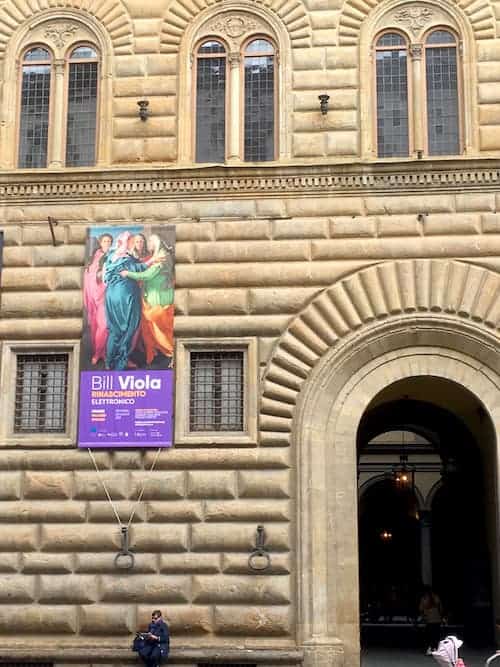
On the Other Hand
by Christina Waters | May 31, 2017 | Art, Home, Travel |
My bags are always packed!
To go from here to there is to indulge in a blend of aesthetic schizophrenia, wanderlust, and bad faith. Insisting that I love exactly where I live, I still climb onto a plane roughly once a year to become whatever the next large foreign city can make of me. Without giving up what I have, I crave what can only be gained sitting at an exotic (df. of foreign origin) table.
 The Other Place vs Home. Each has exactly what the other lacks. The foreign city has architecture, history, and the cultural depth that only a critical mass of people, talent, and creative pressure can create. [It might also offer the spectacle of Korean newlyweds posing for nuptial photos with the Uffizi in the background.]
The Other Place vs Home. Each has exactly what the other lacks. The foreign city has architecture, history, and the cultural depth that only a critical mass of people, talent, and creative pressure can create. [It might also offer the spectacle of Korean newlyweds posing for nuptial photos with the Uffizi in the background.]
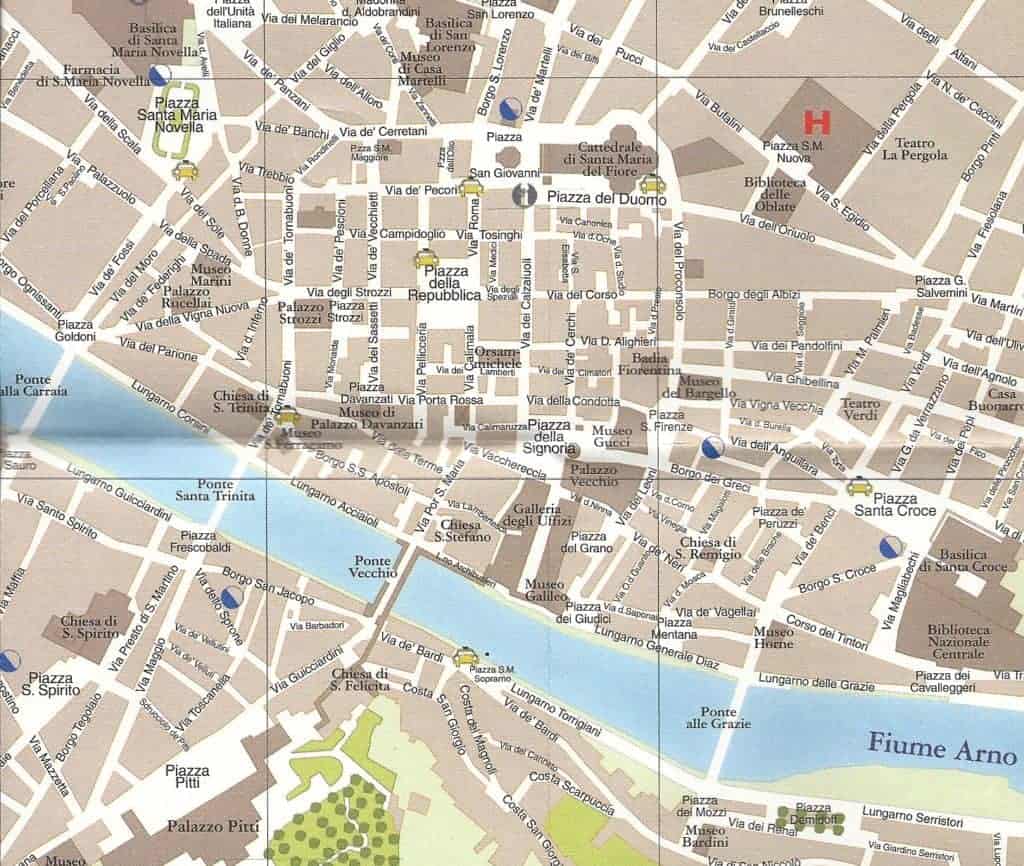    The small seaside town has coziness, hominess, familiarity. Its smaller size allows for intimacy, a sense of geographical mastery that comes with manageable scale. And it is home, a place one has lived in for years. It contains friends, lovers, colleagues—all those whose ideas and eccentricities help construct your own life.
   The small seaside town has coziness, hominess, familiarity. Its smaller size allows for intimacy, a sense of geographical mastery that comes with manageable scale. And it is home, a place one has lived in for years. It contains friends, lovers, colleagues—all those whose ideas and eccentricities help construct your own life.
Somewhere in the exact middle of these two attractive places the wanderer is suspended, not wanting to upset that balance, not wanting to have to choose.
I travel partly in order to see my home from a clearer vantage point, and nothing clarifies like distance (Antonioni knew that. So did Hemingway, and Durrell.) But also to feast and fill up upon the riches of the other—another time, another cultural sensibility, another way of moving, talking, and listening.
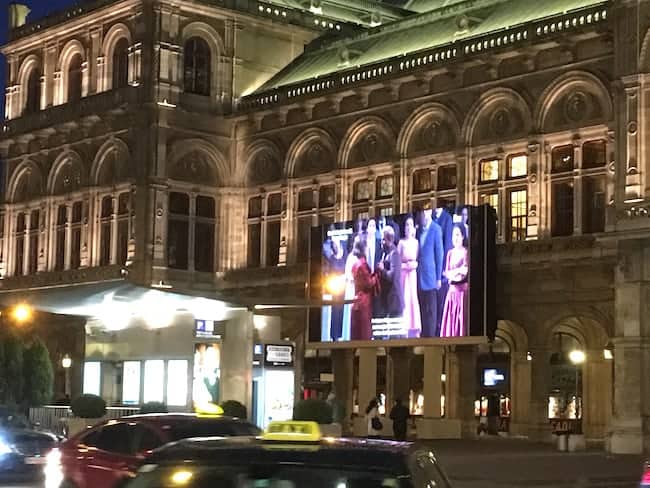 The smell of frankincense that fills the high altar of a cathedral on Sunday mornings speaks to my subconscious DNA. Was I a priest in a past life? The sound of church bells, counting out the hours, calling people to prayer, announcing this or another civic event, is part of the atmospheric soundtrack of European cities. A soundtrack missing from seaside California.
The smell of frankincense that fills the high altar of a cathedral on Sunday mornings speaks to my subconscious DNA. Was I a priest in a past life? The sound of church bells, counting out the hours, calling people to prayer, announcing this or another civic event, is part of the atmospheric soundtrack of European cities. A soundtrack missing from seaside California.
Admiring the bravura of men’s fashion in Italy I am forced to grasp the casual attire of coastal California. I see no baseball caps in Vienna, and I instantly understand the climate, the sun, the outdoor lifestyle that produces our dress code. It’s harder to see when you are in the midst, easy to spot via the extreme contrast of a metropolitan European city founded thousands of years ago by Celts.
I discovered BBC when I was in Paris several decades ago. Even though I loved French TV, the mesmerizing commercials, and pungently-dramatic soap operas, I wanted to hear some of my native language. That’s when I realized that American TV carried on as if there were no weather issues in Africa. No one mentioned incidents in the Sudan, or Myanmar. Chinese business deals weren’t given a second of air time. Bulgaria didn’t exist. The world into which I had traveled was not only larger, but my own country and its media prejudices seemed provincial by comparison.
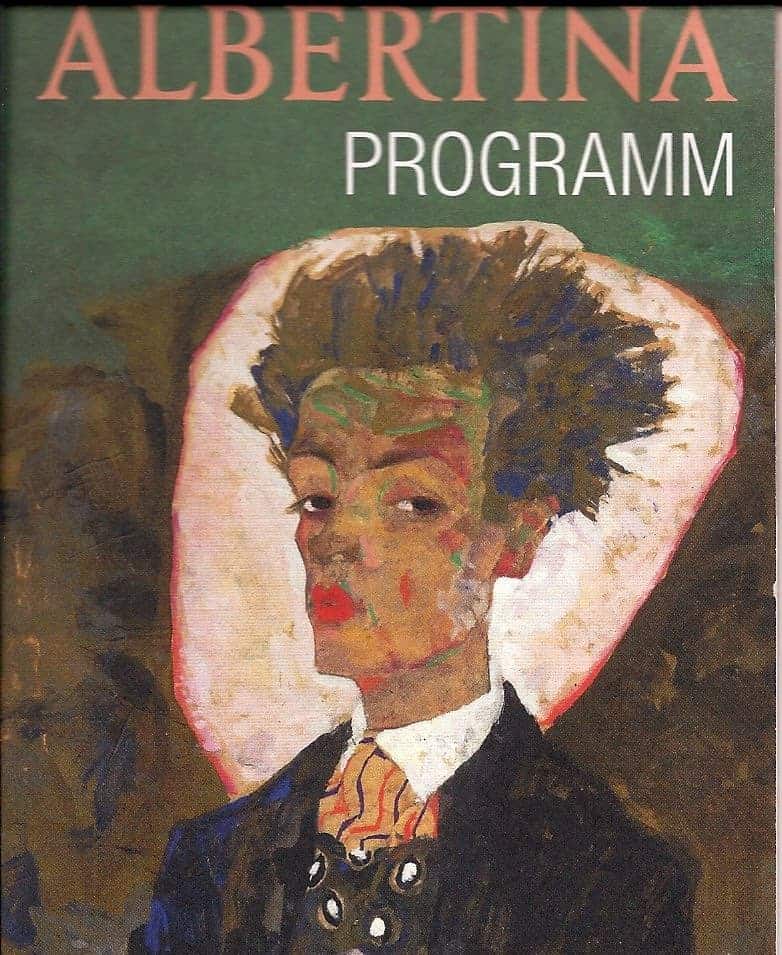 Without question we see ourselves and our cultural assumptions more clearly from afar. Travel removes me from work. I leave my laptop at home. I am frugal with my emails. Here and now details tend to define each day. I visit a museum in Florence and find it filled with engaged high school groups. I visit a Monet show in San Francisco and find it filled with white-haired nostalgics. The youthful energy and passion for the arts in Europe is both encouraging (I envy the Europeans) and sad (I am brusquely reminded of the inattention to art of the past by student-aged Americans). Yes, opera is expensive, but the queue for cheap standing room is a block-long in Vienna. All young people. Outside the US, museum tickets are inexpensive and everyone seems to take advantage of the sensory feast and stimulus to the imagination provided by innovatively-curated exhibitions. And no, I don’t mean simply parading out the content of a wealthy woman’s closet and calling it an art exhibition.
Without question we see ourselves and our cultural assumptions more clearly from afar. Travel removes me from work. I leave my laptop at home. I am frugal with my emails. Here and now details tend to define each day. I visit a museum in Florence and find it filled with engaged high school groups. I visit a Monet show in San Francisco and find it filled with white-haired nostalgics. The youthful energy and passion for the arts in Europe is both encouraging (I envy the Europeans) and sad (I am brusquely reminded of the inattention to art of the past by student-aged Americans). Yes, opera is expensive, but the queue for cheap standing room is a block-long in Vienna. All young people. Outside the US, museum tickets are inexpensive and everyone seems to take advantage of the sensory feast and stimulus to the imagination provided by innovatively-curated exhibitions. And no, I don’t mean simply parading out the content of a wealthy woman’s closet and calling it an art exhibition.
Does travel expand our consciousness? Does the Pope suffer fools?
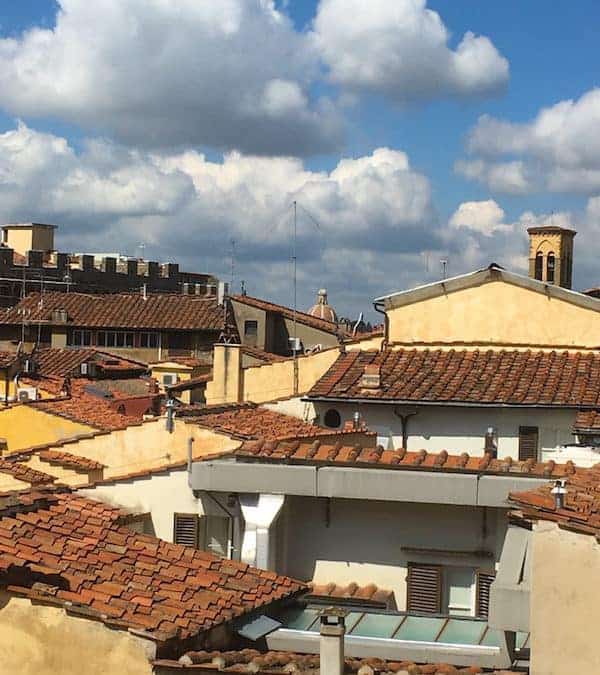
Time Travel Conflicts
by Christina Waters | May 16, 2017 | Art, Home, Travel |
There are many forms of being in conflict with oneself, but few are as universal, if irrational, as that feeling you have after a satisfying trip far away from your everyday life. For two weeks I was lucky enough to be in Vienna and, briefly, Florence. By the end of the richly rewarding journey of sensory pleasures—opera, concerts, art exhibitions, regional cuisine, architecture—it was time to come home. Yet a mere 24 hours after being back, and after soaking up the enjoyment of my sweetheart, my own bed, the foods I love….I longed to be back in a great European city that could not possibly be more different than the small seaside town in California where I live.
What is that about?
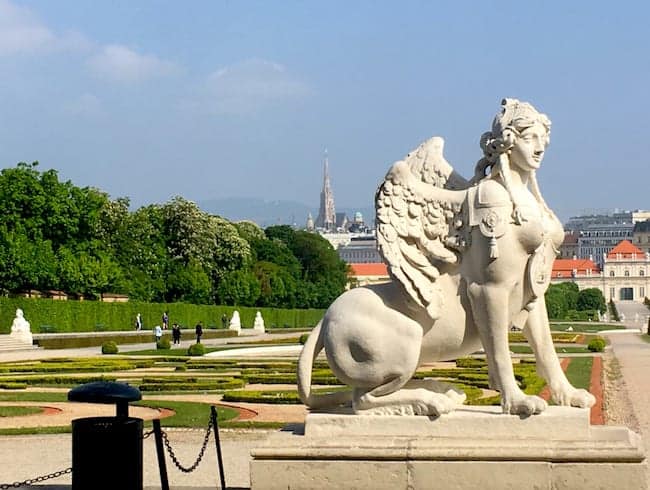 Nothing feels better than coming home after a stretch of time in which each day has required strategizing over where you will eat, whether your grasp of German and Italian (or whatever non-native language) will suffice without causing howls of derision, walking until your feet scream, struggling with jet lag, and dining with strangers or alone with only your cell phone (or a book!) for company. Being at home means never having to say “come se dice “clueless” in Italiano.” Being at home means not having to endure the specific humiliation of being handed a menu in English when you’ve worked your butt off to master restaurant German. Being at home means not having to negotiate hieroglyphic subway signage, taxi prices, the ridiculously small size of street names on maps that you’re trying not to be seen using.
Nothing feels better than coming home after a stretch of time in which each day has required strategizing over where you will eat, whether your grasp of German and Italian (or whatever non-native language) will suffice without causing howls of derision, walking until your feet scream, struggling with jet lag, and dining with strangers or alone with only your cell phone (or a book!) for company. Being at home means never having to say “come se dice “clueless” in Italiano.” Being at home means not having to endure the specific humiliation of being handed a menu in English when you’ve worked your butt off to master restaurant German. Being at home means not having to negotiate hieroglyphic subway signage, taxi prices, the ridiculously small size of street names on maps that you’re trying not to be seen using.
 But as Sartre liked to remind us, nothing makes us feel as alive as struggle. Nor does the successful result leave as lasting an impact as when we had to work for it. Adversity is bracing. And that sense of quest, of having to work for the cold beer at the top of the hill, or that first glimpse of the Duomo after a 12-hour plane trip—these are what sweeten both the present moment, and that lasting memory of travel.
But as Sartre liked to remind us, nothing makes us feel as alive as struggle. Nor does the successful result leave as lasting an impact as when we had to work for it. Adversity is bracing. And that sense of quest, of having to work for the cold beer at the top of the hill, or that first glimpse of the Duomo after a 12-hour plane trip—these are what sweeten both the present moment, and that lasting memory of travel.
 And then there’s the slammed against the wall discomfort and disarray of long-distance travel. The customs lines, the dishevelment of TSA, the spatial cram and compromise of airplane seating, the out-of-body haze of having been semi-conscious for 20 hours and then having to check into a hotel with something close to dignity. [A sidebar you’ll enjoy: as my Slovakian cabbie approached the inner city of Vienna, he was stopped at the bridge over the Donau canal. According to the polizei, all roads to the old city were closed. It was a Friday, the end of April. No explanations. My poor driver was apologetic but he had to let me out right there, with only a few indications of where I should go—straight ahead, turn right, then another left to my hotel. This is after SFO to Frankfurt, Frankfurt to Vienna, 15 hours of travel and loaded down with one huge rolling suitcase and another carry-on case. I had to actually roll both cases through the streets of Vienna, ask for directions twice, then go the long way through throngs of student tour groups and people with selfie sticks all clustered around the huge cathedral, just attempting to stay on my feet. Arms aching, utterly wiped out, I made it to my hotel. Not my best travel memory.]
And then there’s the slammed against the wall discomfort and disarray of long-distance travel. The customs lines, the dishevelment of TSA, the spatial cram and compromise of airplane seating, the out-of-body haze of having been semi-conscious for 20 hours and then having to check into a hotel with something close to dignity. [A sidebar you’ll enjoy: as my Slovakian cabbie approached the inner city of Vienna, he was stopped at the bridge over the Donau canal. According to the polizei, all roads to the old city were closed. It was a Friday, the end of April. No explanations. My poor driver was apologetic but he had to let me out right there, with only a few indications of where I should go—straight ahead, turn right, then another left to my hotel. This is after SFO to Frankfurt, Frankfurt to Vienna, 15 hours of travel and loaded down with one huge rolling suitcase and another carry-on case. I had to actually roll both cases through the streets of Vienna, ask for directions twice, then go the long way through throngs of student tour groups and people with selfie sticks all clustered around the huge cathedral, just attempting to stay on my feet. Arms aching, utterly wiped out, I made it to my hotel. Not my best travel memory.]
 There’s more to ponder here. Once jetlag and the utter exhaustion of the long flight wore off, I began to walk the streets, learn where my favorite new cafes were, meet up with fellow opera-lovers for the many evenings of great music, revisit museums I hadn’t seen since grad school. In other words, I began residency in a new world. I had carved out yet another life, a new identity in which I was psychologically at least in two places at once.
There’s more to ponder here. Once jetlag and the utter exhaustion of the long flight wore off, I began to walk the streets, learn where my favorite new cafes were, meet up with fellow opera-lovers for the many evenings of great music, revisit museums I hadn’t seen since grad school. In other words, I began residency in a new world. I had carved out yet another life, a new identity in which I was psychologically at least in two places at once.
And that may be the key to this double bind, this longing to be home while wishing to be traveling again. Going far enough away from familiar scenes that you are forced to see differently, move differently, speak differently, creates a new existence. I had extended my life by two weeks, carving out more time and more space while still being my “real” self in my “real” identity.
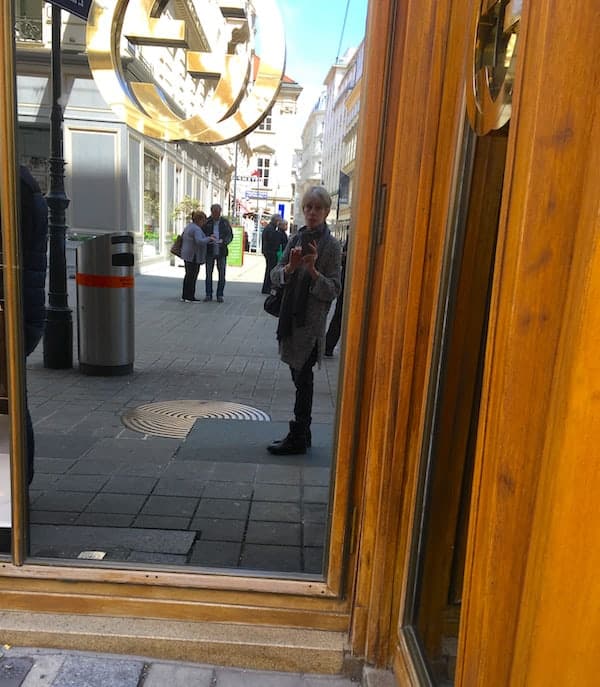 Travel gives us not only new spaces, it gives us more time. And the illusion of an expanded life. I can live in two places at once. At least for a while—as long as my feet (and my money) hold out.
Travel gives us not only new spaces, it gives us more time. And the illusion of an expanded life. I can live in two places at once. At least for a while—as long as my feet (and my money) hold out.






 Before you know it the Kims, who’ll literally do anything to make money, manage to insinuate themselves into the heart of the Park’s splendid household. It is a symbiotic ecosystem made in the hellishly brilliant imagination of this director.
Before you know it the Kims, who’ll literally do anything to make money, manage to insinuate themselves into the heart of the Park’s splendid household. It is a symbiotic ecosystem made in the hellishly brilliant imagination of this director.
 The house itself is a key player in what will reveal itself to be Bong’s sly-handed tale of social inequity. An architectural masterpiece (designed by director Bong and made especially for the film) the sleek modernist house is laid out in interlocking levels. The living room’s enormous wall of glass overlooks an oasis of green lawn bordered by a manicured hedge.
The house itself is a key player in what will reveal itself to be Bong’s sly-handed tale of social inequity. An architectural masterpiece (designed by director Bong and made especially for the film) the sleek modernist house is laid out in interlocking levels. The living room’s enormous wall of glass overlooks an oasis of green lawn bordered by a manicured hedge.  This hermetic world insulates the Parks from any unsightly social reality and makes a painful contrast to the mess and chaos of the Kim’s basement apartment. Most importantly to the director’s storytelling, the house also contains a secret passage into yet another domain—and a ghastly secret buried deep within the heart of lavish wealth.
This hermetic world insulates the Parks from any unsightly social reality and makes a painful contrast to the mess and chaos of the Kim’s basement apartment. Most importantly to the director’s storytelling, the house also contains a secret passage into yet another domain—and a ghastly secret buried deep within the heart of lavish wealth.
 And once the shocking visual pyrotechnics have cooled down, the film draws to a haunting, eloquent close a la Charles Dickens. Desperate and ephemeral dreams, of the sort that reveal how much the rich and the poor are mutually bound in a slow dance of need, greed, hypocrisy, and desire.
And once the shocking visual pyrotechnics have cooled down, the film draws to a haunting, eloquent close a la Charles Dickens. Desperate and ephemeral dreams, of the sort that reveal how much the rich and the poor are mutually bound in a slow dance of need, greed, hypocrisy, and desire.

 On the adjacent wall, Viola’s larger-than-lifesize figures strain against time and space in hyper slow motion, re-imagining the meeting (the piece is called The Greeting) among Mary, Elizabeth, and a third woman. Gracefully surging skirts, arms reaching out, hands about to clasp, faces registering surprise, delight, and puzzlement, Viola’s work—which takes time to unfold— forces us deep into and beneath the minds of his subjects.
On the adjacent wall, Viola’s larger-than-lifesize figures strain against time and space in hyper slow motion, re-imagining the meeting (the piece is called The Greeting) among Mary, Elizabeth, and a third woman. Gracefully surging skirts, arms reaching out, hands about to clasp, faces registering surprise, delight, and puzzlement, Viola’s work—which takes time to unfold— forces us deep into and beneath the minds of his subjects. The slowed-down movements and gestures cast digital congianti onto the image painted by Bronzino’s teacher in the early 16th century. Movement inflects stillness with layers of temporal depth. Absolutely stunning. Viola’s forensic probing of an emotion-drenched moment retrieves fresh sensations we can almost taste.
The slowed-down movements and gestures cast digital congianti onto the image painted by Bronzino’s teacher in the early 16th century. Movement inflects stillness with layers of temporal depth. Absolutely stunning. Viola’s forensic probing of an emotion-drenched moment retrieves fresh sensations we can almost taste. The Pontormo is triumphant, its colors brilliant as if freshly painted. A commanding palette of draped robes challenges the crimson dress worn Viola’s Mary, the magenta shawl of Elizabeth.The two works now share a secret, at once timeless and yet produced across and through time; they murmur of the same epic event. They are in league with each other. Sono insieme.
The Pontormo is triumphant, its colors brilliant as if freshly painted. A commanding palette of draped robes challenges the crimson dress worn Viola’s Mary, the magenta shawl of Elizabeth.The two works now share a secret, at once timeless and yet produced across and through time; they murmur of the same epic event. They are in league with each other. Sono insieme. So it was with great anticipation that I took a break from operas in Vienna last month, hopped a plane across the alps, and headed for the Palazzo Strozzi in Florence. Curated with insight and largesse by Viola’s longtime collaborator and wife Kira Perov, with Arturo Galansino, the retrospective—Electronic Renaissance—honors the years Viola spent as a student and pioneer videographer in Florence. Indeed, the city opened its doors to Viola’s work, displaying pieces in multiiple sites from the Museo del Duomo to the entire Palazzo Strozzi.
So it was with great anticipation that I took a break from operas in Vienna last month, hopped a plane across the alps, and headed for the Palazzo Strozzi in Florence. Curated with insight and largesse by Viola’s longtime collaborator and wife Kira Perov, with Arturo Galansino, the retrospective—Electronic Renaissance—honors the years Viola spent as a student and pioneer videographer in Florence. Indeed, the city opened its doors to Viola’s work, displaying pieces in multiiple sites from the Museo del Duomo to the entire Palazzo Strozzi. Like many of you, I had seen several of Viola’s pieces years ago at The Getty, and was familiar with his technique of hyper attenuated movement. The smallest blink of an eye, or grasp of a hand—actually happening in seconds—is stretched and lengthened into many minutes. The gestures seems to develop and bloom as we watch. Time itself unfolds through Viola’s unblinking camera, and an unseen symbolic power is revealed.
Like many of you, I had seen several of Viola’s pieces years ago at The Getty, and was familiar with his technique of hyper attenuated movement. The smallest blink of an eye, or grasp of a hand—actually happening in seconds—is stretched and lengthened into many minutes. The gestures seems to develop and bloom as we watch. Time itself unfolds through Viola’s unblinking camera, and an unseen symbolic power is revealed. The Emergence, based upon an enigmatic and solumn 15th century work by Masolino is the exhibition’s signature work, and one in which Viola documents the naked Christ figure, emerging (as in a resurrection) and also ascending from a watery death, tenderly wrapped by two women (his mother Mary and the Magdalen, as the new testament tells it).
The Emergence, based upon an enigmatic and solumn 15th century work by Masolino is the exhibition’s signature work, and one in which Viola documents the naked Christ figure, emerging (as in a resurrection) and also ascending from a watery death, tenderly wrapped by two women (his mother Mary and the Magdalen, as the new testament tells it). Displaying over a period of 15 minutes, the work uses its fascinating beauty (we are always wondering how it was made, noticing the arduousness of the actors’ movements) to enunciate a mysterious truth. We are watching a familiar moment, a primal moment we know in our bodies. Yet that moment has no name. It is deeper than naming. Viola knows that. The piece is nothing short of profound, kept watch over by the original Masolino alterpiece.
Displaying over a period of 15 minutes, the work uses its fascinating beauty (we are always wondering how it was made, noticing the arduousness of the actors’ movements) to enunciate a mysterious truth. We are watching a familiar moment, a primal moment we know in our bodies. Yet that moment has no name. It is deeper than naming. Viola knows that. The piece is nothing short of profound, kept watch over by the original Masolino alterpiece. Dinner of pappardelle and wild boar ragu, chased with Chianti Classico. Next morning I saw more Viola pieces at the Museo del Opera del Duomo, and was ensnared in the tragic mirroring of Donatello‘s carved wood Magdalen—a work of numbing sorrow with Viola’s Acceptance—a lifesize video of a wailing nude woman inundated with torrents of water. The carved wooden animal hides covering the Magdalen were exactly echoed by the roiling flood, a stream of slow-motion tears. Stunned, I headed back for a second viewing of the Palazzo Strozzi show. Ten dollars was never better spent.
Dinner of pappardelle and wild boar ragu, chased with Chianti Classico. Next morning I saw more Viola pieces at the Museo del Opera del Duomo, and was ensnared in the tragic mirroring of Donatello‘s carved wood Magdalen—a work of numbing sorrow with Viola’s Acceptance—a lifesize video of a wailing nude woman inundated with torrents of water. The carved wooden animal hides covering the Magdalen were exactly echoed by the roiling flood, a stream of slow-motion tears. Stunned, I headed back for a second viewing of the Palazzo Strozzi show. Ten dollars was never better spent. And here I walked into my own epiphany. I moved from darkened room to darkened room on Viola’s shamanic journey. The exhibition had cast a hypnotic spell, into which I, the seeker, descended deeper and deeper until I came to the room with a piece I had known about for many years—Catherine’s Room. Five panels showing the stages of a life, the time of life (youth, middle-age, etc.) symbolized by the view of a tree outside Catherin’e window. In her youth, the tree is beginning to bloom. As she grows into maturity, the tree is seen awash with green leaves, the sun high in the sky. As she grows older, the sky outside grows darker, the tree’s leaves fall. In the final panel, we watch as she makes her bed and lies down in it pulling up the covers. The window is dark, night has fallen.
And here I walked into my own epiphany. I moved from darkened room to darkened room on Viola’s shamanic journey. The exhibition had cast a hypnotic spell, into which I, the seeker, descended deeper and deeper until I came to the room with a piece I had known about for many years—Catherine’s Room. Five panels showing the stages of a life, the time of life (youth, middle-age, etc.) symbolized by the view of a tree outside Catherin’e window. In her youth, the tree is beginning to bloom. As she grows into maturity, the tree is seen awash with green leaves, the sun high in the sky. As she grows older, the sky outside grows darker, the tree’s leaves fall. In the final panel, we watch as she makes her bed and lies down in it pulling up the covers. The window is dark, night has fallen. Each panel is also a video piece, so we can watch each image unfold in slow-motion time. And we can take it all in at once, embrace the entire polyptych as a whole.
Each panel is also a video piece, so we can watch each image unfold in slow-motion time. And we can take it all in at once, embrace the entire polyptych as a whole.
 The Other Place vs Home. Each has exactly what the other lacks. The foreign city has architecture, history, and the cultural depth that only a critical mass of people, talent, and creative pressure can create. [It might also offer the spectacle of Korean newlyweds posing for nuptial photos with the Uffizi in the background.]
The Other Place vs Home. Each has exactly what the other lacks. The foreign city has architecture, history, and the cultural depth that only a critical mass of people, talent, and creative pressure can create. [It might also offer the spectacle of Korean newlyweds posing for nuptial photos with the Uffizi in the background.]    The small seaside town has coziness, hominess, familiarity. Its smaller size allows for intimacy, a sense of geographical mastery that comes with manageable scale. And it is home, a place one has lived in for years. It contains friends, lovers, colleagues—all those whose ideas and eccentricities help construct your own life.
   The small seaside town has coziness, hominess, familiarity. Its smaller size allows for intimacy, a sense of geographical mastery that comes with manageable scale. And it is home, a place one has lived in for years. It contains friends, lovers, colleagues—all those whose ideas and eccentricities help construct your own life. The smell of frankincense that fills the high altar of a cathedral on Sunday mornings speaks to my subconscious DNA. Was I a priest in a past life? The sound of church bells, counting out the hours, calling people to prayer, announcing this or another civic event, is part of the atmospheric soundtrack of European cities. A soundtrack missing from seaside California.
The smell of frankincense that fills the high altar of a cathedral on Sunday mornings speaks to my subconscious DNA. Was I a priest in a past life? The sound of church bells, counting out the hours, calling people to prayer, announcing this or another civic event, is part of the atmospheric soundtrack of European cities. A soundtrack missing from seaside California. Without question we see ourselves and our cultural assumptions more clearly from afar. Travel removes me from work. I leave my laptop at home. I am frugal with my emails. Here and now details tend to define each day. I visit a museum in Florence and find it filled with engaged high school groups. I visit a Monet show in San Francisco and find it filled with white-haired nostalgics. The youthful energy and passion for the arts in Europe is both encouraging (I envy the Europeans) and sad (I am brusquely reminded of the inattention to art of the past by student-aged Americans). Yes, opera is expensive, but the queue for cheap standing room is a block-long in Vienna. All young people. Outside the US, museum tickets are inexpensive and everyone seems to take advantage of the sensory feast and stimulus to the imagination provided by innovatively-curated exhibitions. And no, I don’t mean simply parading out the content of a wealthy woman’s closet and calling it an art exhibition.
Without question we see ourselves and our cultural assumptions more clearly from afar. Travel removes me from work. I leave my laptop at home. I am frugal with my emails. Here and now details tend to define each day. I visit a museum in Florence and find it filled with engaged high school groups. I visit a Monet show in San Francisco and find it filled with white-haired nostalgics. The youthful energy and passion for the arts in Europe is both encouraging (I envy the Europeans) and sad (I am brusquely reminded of the inattention to art of the past by student-aged Americans). Yes, opera is expensive, but the queue for cheap standing room is a block-long in Vienna. All young people. Outside the US, museum tickets are inexpensive and everyone seems to take advantage of the sensory feast and stimulus to the imagination provided by innovatively-curated exhibitions. And no, I don’t mean simply parading out the content of a wealthy woman’s closet and calling it an art exhibition.
 Nothing feels better than coming home after a stretch of time in which each day has required strategizing over where you will eat, whether your grasp of German and Italian (or whatever non-native language) will suffice without causing howls of derision, walking until your feet scream, struggling with jet lag, and dining with strangers or alone with only your cell phone (or a book!) for company. Being at home means never having to say “come se dice “clueless” in Italiano.” Being at home means not having to endure the specific humiliation of being handed a menu in English when you’ve worked your butt off to master restaurant German. Being at home means not having to negotiate hieroglyphic subway signage, taxi prices, the ridiculously small size of street names on maps that you’re trying not to be seen using.
Nothing feels better than coming home after a stretch of time in which each day has required strategizing over where you will eat, whether your grasp of German and Italian (or whatever non-native language) will suffice without causing howls of derision, walking until your feet scream, struggling with jet lag, and dining with strangers or alone with only your cell phone (or a book!) for company. Being at home means never having to say “come se dice “clueless” in Italiano.” Being at home means not having to endure the specific humiliation of being handed a menu in English when you’ve worked your butt off to master restaurant German. Being at home means not having to negotiate hieroglyphic subway signage, taxi prices, the ridiculously small size of street names on maps that you’re trying not to be seen using. But as Sartre liked to remind us, nothing makes us feel as alive as struggle. Nor does the successful result leave as lasting an impact as when we had to work for it. Adversity is bracing. And that sense of quest, of having to work for the cold beer at the top of the hill, or that first glimpse of the Duomo after a 12-hour plane trip—these are what sweeten both the present moment, and that lasting memory of travel.
But as Sartre liked to remind us, nothing makes us feel as alive as struggle. Nor does the successful result leave as lasting an impact as when we had to work for it. Adversity is bracing. And that sense of quest, of having to work for the cold beer at the top of the hill, or that first glimpse of the Duomo after a 12-hour plane trip—these are what sweeten both the present moment, and that lasting memory of travel. And then there’s the slammed against the wall discomfort and disarray of long-distance travel. The customs lines, the dishevelment of TSA, the spatial cram and compromise of airplane seating, the out-of-body haze of having been semi-conscious for 20 hours and then having to check into a hotel with something close to dignity. [A sidebar you’ll enjoy: as my Slovakian cabbie approached the inner city of Vienna, he was stopped at the bridge over the Donau canal. According to the polizei, all roads to the old city were closed. It was a Friday, the end of April. No explanations. My poor driver was apologetic but he had to let me out right there, with only a few indications of where I should go—straight ahead, turn right, then another left to my hotel. This is after SFO to Frankfurt, Frankfurt to Vienna, 15 hours of travel and loaded down with one huge rolling suitcase and another carry-on case. I had to actually roll both cases through the streets of Vienna, ask for directions twice, then go the long way through throngs of student tour groups and people with selfie sticks all clustered around the huge cathedral, just attempting to stay on my feet. Arms aching, utterly wiped out, I made it to my hotel. Not my best travel memory.]
And then there’s the slammed against the wall discomfort and disarray of long-distance travel. The customs lines, the dishevelment of TSA, the spatial cram and compromise of airplane seating, the out-of-body haze of having been semi-conscious for 20 hours and then having to check into a hotel with something close to dignity. [A sidebar you’ll enjoy: as my Slovakian cabbie approached the inner city of Vienna, he was stopped at the bridge over the Donau canal. According to the polizei, all roads to the old city were closed. It was a Friday, the end of April. No explanations. My poor driver was apologetic but he had to let me out right there, with only a few indications of where I should go—straight ahead, turn right, then another left to my hotel. This is after SFO to Frankfurt, Frankfurt to Vienna, 15 hours of travel and loaded down with one huge rolling suitcase and another carry-on case. I had to actually roll both cases through the streets of Vienna, ask for directions twice, then go the long way through throngs of student tour groups and people with selfie sticks all clustered around the huge cathedral, just attempting to stay on my feet. Arms aching, utterly wiped out, I made it to my hotel. Not my best travel memory.] There’s more to ponder here. Once jetlag and the utter exhaustion of the long flight wore off, I began to walk the streets, learn where my favorite new cafes were, meet up with fellow opera-lovers for the many evenings of great music, revisit museums I hadn’t seen since grad school. In other words, I began residency in a new world. I had carved out yet another life, a new identity in which I was psychologically at least in two places at once.
There’s more to ponder here. Once jetlag and the utter exhaustion of the long flight wore off, I began to walk the streets, learn where my favorite new cafes were, meet up with fellow opera-lovers for the many evenings of great music, revisit museums I hadn’t seen since grad school. In other words, I began residency in a new world. I had carved out yet another life, a new identity in which I was psychologically at least in two places at once. Travel gives us not only new spaces, it gives us more time. And the illusion of an expanded life. I can live in two places at once. At least for a while—as long as my feet (and my money) hold out.
Travel gives us not only new spaces, it gives us more time. And the illusion of an expanded life. I can live in two places at once. At least for a while—as long as my feet (and my money) hold out.